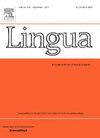韩国语视觉词识别过程中名词和谓词加工的脑激活
IF 1.3
3区 文学
0 LANGUAGE & LINGUISTICS
引用次数: 0
摘要
本研究探讨了韩国语词形复杂的名词词形和谓语词形加工的神经机制。在词汇决策任务中,我们使用功能性磁共振成像(fMRI)检查了这两种词汇类型的大脑激活模式。结果表明,共享和不同的神经激活模式:共享区域,包括舌回和中央前区,与初级视觉处理和高级认知功能有关。在双侧额下回中观察到明显的激活,特别是在谓词额下回,这可能与它们更高的形态句法复杂性和增加的认知负荷有关。行为数据与这些发现相一致,表明预测Eojeols的反应时间较慢,准确性较低。在讨论中,我们认为形态复杂性导致了基于谓词和基于名词的外来语的处理方式的差异,这可能为印欧语言以外的语言处理提供见解。本文章由计算机程序翻译,如有差异,请以英文原文为准。
Brain activation in noun-based- and predicate-Eojeol processing during Korean visual word recognition
This study explored the neural mechanisms involved in processing noun-based- and predicate-Eojeols, morphologically complex word forms in the Korean language. Using functional magnetic resonance imaging (fMRI) during a lexical decision task, we examined brain activation patterns for these two word types. The results indicated both shared and distinct neural activation patterns: shared regions, including the lingual gyrus and precentral areas, were associated with primary visual processing and higher-order cognitive functions. Distinct activation was observed in the bilateral inferior frontal gyrus, particularly for predicate Eojeols, which may be related to their greater morpho-syntactic complexity and increased cognitive load. Behavioral data aligned with these findings, showing slower reaction times and lower accuracy for predicate Eojeols. In discussion, we suggest that morphological complexity contributes to differences in how predicate- and noun-based-Eojeols are processed, which could offer insights into language processing beyond Indo-European languages.
求助全文
通过发布文献求助,成功后即可免费获取论文全文。
去求助
来源期刊

Lingua
Multiple-
CiteScore
2.50
自引率
9.10%
发文量
93
审稿时长
24 weeks
期刊介绍:
Lingua publishes papers of any length, if justified, as well as review articles surveying developments in the various fields of linguistics, and occasional discussions. A considerable number of pages in each issue are devoted to critical book reviews. Lingua also publishes Lingua Franca articles consisting of provocative exchanges expressing strong opinions on central topics in linguistics; The Decade In articles which are educational articles offering the nonspecialist linguist an overview of a given area of study; and Taking up the Gauntlet special issues composed of a set number of papers examining one set of data and exploring whose theory offers the most insight with a minimal set of assumptions and a maximum of arguments.
 求助内容:
求助内容: 应助结果提醒方式:
应助结果提醒方式:


